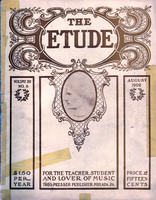A lady writes me that she is the fortunate possessor of a fiddle made by Stradivarius seven years before his death. Owing to certain circumstances she has decided to part with her fiddle, and wishes to know where she would be likely to find a purchaser. My correspondent further informs me that she is willing to sell her fiddle for “from eight to ten thousand dollars,” and I am led to suppose that she regards any sum less than eight thousand dollars as wholly inadequate for the instrument in her possession.
I am going to tell my readers how this lady happens to know that her fiddle was made by the great Italian master. She had so little difficulty in reaching a decision as to the origin of her instrument that, in divulging her secret to mankind in general and my readers in particular, I feel that I shall earn the gratitude of millions.
Mrs. X—let us call her so—has a fiddle that has been in her possession for many years. She knows that it is very, very ancient, because her father’s father’s uncle’s brother (or some such remote and noncommittal ancestor) bought it from an old and feeble Italian whose great-grandfather had lived in Cremona. This is an excellent beginning, as my intelligent readers will admit; for had the great-grandfather of the old Italian who sold the fiddle to Mrs. X’s father’s father’s uncle’s brother been born in Dublin, it might be difficult to convince fiddle-lovers of the present century that this fiddle had been fashioned by the cunning hand of Antonio Stradivarius. But, as the matter stands, only a sneering skeptic could harbor the suspicion that this instrument might possibly be a recent importation from Markneukirchen, Germany.
Now let us see by what an absurdly simple process of reasoning Mrs. X possessed herself of the knowledge that her fiddle is a genuine Stradivarius.
Until recent years the fiddle lay neglected in the garret. Timid mice scampered over its strings and were frightened by the sounds they produced; but the bolder, sophisticated rats sniffed the strings suspiciously, and, finding no cause for alarm, ate them in E-A-D-G order with commendable musical appreciation.
On a raw, drizzly day in November the postman brought Mrs. X the Sunday edition of the New York Herald. She seated herself close to the cheerful grate- fire and systematically proceeded to acquaint herself with the happenings of this degenerate world. Three blood-curdling murders and fourteen divorce cases had been devoured with all their interesting details when Mrs. X’s eye was attracted by the following headlines:
A $10,000 FIDDLE
Bearing the Label
“Antonius Stradiuarius Cremonensis
faciebat anno 1710”
Bought by Professor Zmidkewski.
The lady’s heart stood still. And well it might; for in the garret lay a fiddle that her father’s father’s uncle’s brother had bought from a decrepit Italian whose great-grandfather had lived in Cremona. She flew to the garret and rescued her fiddle from two wise old rodents that were investigating the virtues of the finger-board and bridge. Trembling with fear and expectation she peered through the dust-laden f-holes, and lo! there was the little label bearing Antonius Stradivarius’ name.
This is the briefest account of Mrs. X’s wonderful discovery. It was all so simple and so conclusive that no one can fail to see that Mrs. X’s discovery must result in universal joy. In all parts of the civilized globe exist fiddles bearing the joy-giving label, and their owners have but to peer through the left f-hole in order to satisfy themselves and credulous mankind that their fiddles were born in the workshop of the great Antonio.



